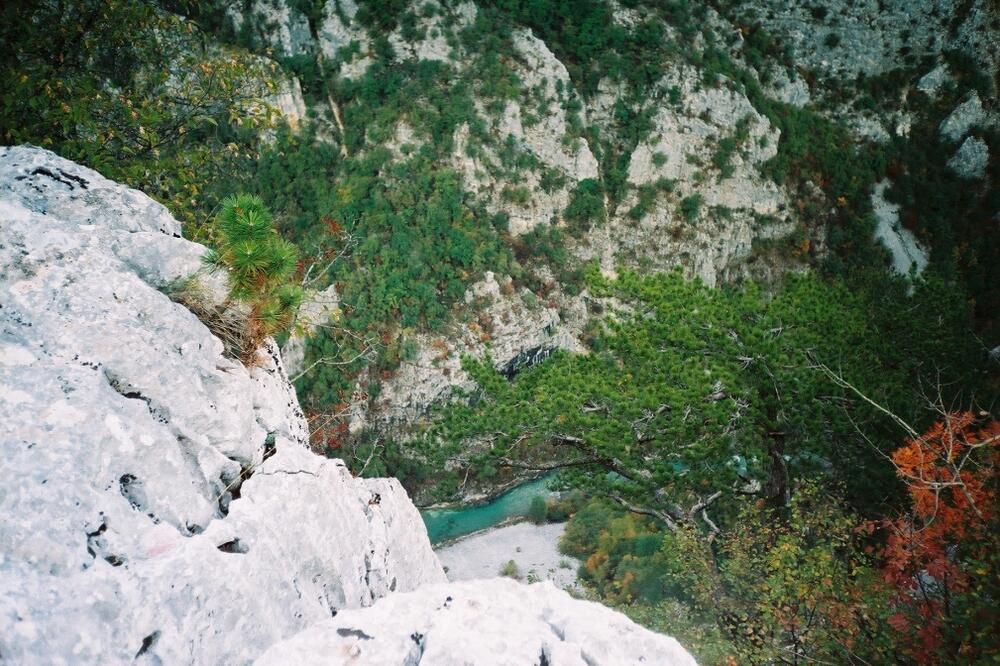We are entering the territory of the municipality of Plužine, which is one of the largest in Montenegro by area, and the least populated.
Everything is in the colors of the painter's palette: red, blush, soft yellow, yellowish, yellow, green, speckled on ash, birch, pine, cerus...
We turn into the long valley of Brezna. We stop in the ethnic village of Montenegro and get a kind of prospectus. The offer is sweeping and enticing. Sightseeing from the height of the Komarnica canyon, descent to the river, Piva lake cruise, jeep safari, Tara rafting, tour of the Durmitor massif... Excursions are offered to the Komarnica, Sušice, Nevidio canyons, which are a true wonder of nature, almost inaccessible, say the most impassable canyon in the world, to the Čavčalica and Bezdanica caves, seven viewpoints (from the Orlova glavica viewpoint, at 600 meters, you can see the Komarnica canyon), a hundred kilometers of forest paths for walking... The ethno village is, at least by name, diverse: canyon huts, honey huts, ethnic huts, disneyland huts, sleigh bungalows. Brezna is an open valley with beckoning views. Everything that is written is a fairy tale. The live experience trumps everything.
Near the ethnic village, we passed through a forest and suddenly a terrible gap, a chasm, opened up in front of/below us... the canyon of Komarnica, 400 meters down. It is a moment of admiration and awe. One can cautiously stand on the plateau and gaze at the sight of the river that flows deep there, turbulently, through the bed all around in the trees. I lay down on the board and stared...
I also looked for a view from the rock to the right. Far above the river, a hamlet can be seen and in it a house with a red roof as if it fell from the sky.
Lake Piva submerged all the valleys, the town of Plužine, and became, with a length of 42 km, the largest artificial lake in the Balkans.
The Piva Monastery from the valley was faithfully transferred to a new place. I visited him later. It is full of valuables: 1260 square meters of frescoes, 4 gospels, the gramat of the Russian Emperor Alexander I, the Bishop's table, the wheel of the Mother of God and the largest treasury of Montenegro.
With all the benefits of the hydroelectric power plant, which I admit, I cannot regret the sinking of the Piva Eye and the Odmut Cave. I saw the beer eye vividly, drank water and washed in June 1958, when I made a pilgrimage on foot to Sutjeska with a group of ferials, on the 15th anniversary of the famous battle in the People's Liberation Anti-Fascist Struggle in the Second World War. I dedicated a poem to the beer eye. Odmut, once at the mouth of the Vrbnica river in Pivo, was an archaeological site ten thousand years old, with seven layers, the oldest from the Mesolithic, two from the Neolithic, three from the Eneolithic, the youngest from the Early Bronze Age. It is significant for the prehistory of Montenegro that the finds in the cave confirm the cultural connections of the Piva region with the Danube and the Adriatic, as researched by the famous archaeologist Dragoslav Srejović. (Čedomir Mirković, Archaeological Science in Montenegro, Matica, 13/14, Cetinje, Podgorica 2003, p. 106)
A lake and a view of high mountains covered with snow opened up in front of us: Maglić and Volujak. In the said trip, we passed to the right of the mountains. Now everything lit by the sun looks unreal...
(A record of a visit to Komarnica together with my friend Mirko Nilević, from the notebook Crna Gora s neba, prepared for the press in 2009.) I also found support in my text: Dušan Ičević, Ecological state maintains Montenegro, Vijesti, 11 May 5.
Bonus video:




